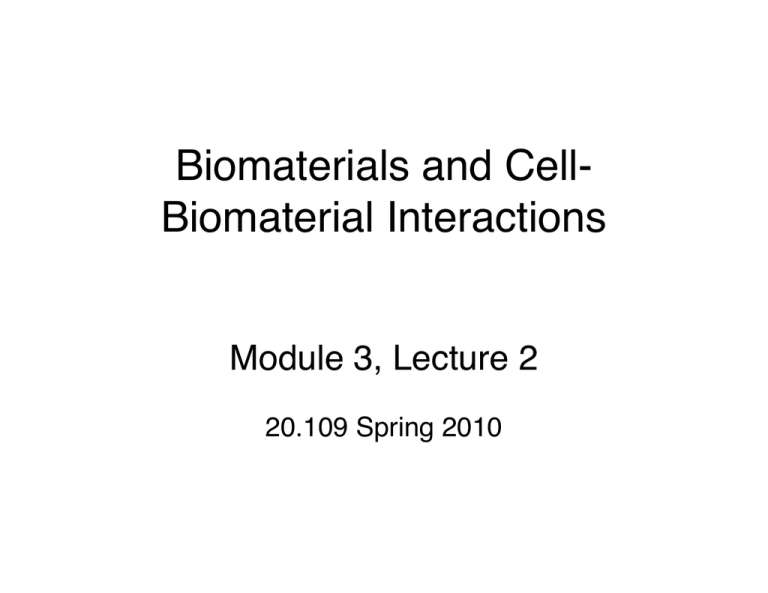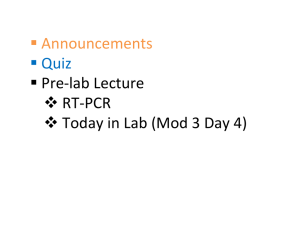Biomaterials and Cell- Biomaterial Interactions! Module 3, Lecture 2 !
advertisement

Biomaterials and CellBiomaterial Interactions! Module 3, Lecture 2! 20.109 Spring 2010! Lecture 1 review! •! What is tissue engineering?" •! Why is tissue engineering?" •! Why care about cartilage?" •! What are we asking in Module 3?" 2! Topics for Lecture 2! •! Introduction to biomaterials" –! properties" –! examples" •! Cartilage composition" –! collagen" –! proteoglycans" 3! Module 3 goals! •! Lab concepts/techniques" –! Mammalian cell culture" –! Phenotypic assays" •! Short informal report" –! Accountability to 20.109 community" •! Discussions in lecture" –! Engage with meta-scientic issues, ethics, etc." •! Research idea presentation" –! Investigate literature independently" –! Exercise scientic creativity" –! Design experiments to address a specic question" 4! Today in Lab: M3D2! 0.5 mL beads, 6 mL media! 0.5 mL beads, 6 mL media! 1 condition per plate (2 plates total).! 2 wells per plate (split 1 mL of beads).! 1 well for viability test, 1 for collagen tests.! 5! Properties of biomaterials! •! Physical/mechanical" –! strength" –! elasticity" –! architecture (e.g., pore size)" •! Chemical" –! degradability" –! water content" –! toxicity" •! Biological" OH! O! OH! O! O-! –! motifs that cells recognize " –! release of biological components" •! Lifetime" 6! The right material for the job! •! Metals" •! –! Ti, Co, Mg alloys" –! pros: mechanically robust" –! applications: orthopedics, dentistry " Ceramics" Metal hip implant! © Biomet, Inc. All rights reserved. This content is excluded from our Creative Commons license. For more information, see http://ocw.mit.edu/fairuse. –! Al2O3, Ca-phosphates, sulfates" –! pros: strength, bonding to bone" –! applications: orthopedics, dentistry" http://www.weisshospital.com/ ! joint-university/hip/metal.html •! Polymers " –! diverse, tunable properties" –! applications: soft tissues" General: B. Ratner, ed. Biomaterials Science, 1996." Image: Porter et al., Biomaterials 25:3303 (2004)." Si-HA! Bone! 7! Courtesy of Elsevier, Inc., http://www.sciencedirect.com. Used with permission. Polymers are diverse and tunable! •! Linear polymers" –! repeated chemical unit" •! Co-polymers" O! O! –! heterogeneous repeats" •! With increasing MW get" Poly(ethylene glycol)! –! increased entanglements" –! increased strength" –! decreased processability" •! Varying properties" –! –! –! –! –! hydrophilicity" gas permeability" stability" ease of chemical modication" mechanical properties" Poly(lactic-co-glycolic acid)! [public domain image]! Free radical polymerization! =! Linear polymers" =! =! =! acrylate " =! UV! =! *!=! =!*! + initiator! =! radical" *! =! =! •! Network structure" –! covalently cross-linked chains" –! water-swollen (if hydrophilic)" Network polymer" 9! Properties of hydrogels! •! Mimic soft tissues" –! water content" –! elasticity" –! diffusivity" •! Synthesis at physiological conditions" –! temperature " –! pH " –! UV light: spatio-temporal control; safe" (Stachowiak & Irvine)" •! Injectability" •! Chemical modication" Review: Nguyen KT & West JL, Biomaterials 23:4307 (2002)" 10! Materials must be biocompatible! •! Avoid bio-incompatibility" –! –! –! –! Normal artery" immunogenicity" bacterial adhesion" clot formation" toxicity" •! Material properties" –! sterility" –! resistance to protein adhesion" –! material and its degradation products non-toxic" Occluded artery" Images from: Zavan B, et al., FASEB J 22:2853 (2008)." 11! . © 2008 FASEB. All rights reserved. This content is excluded from our Creative Commons license. For more information, see http://ocw.mit.edu/fairuse Beyond bioinert: bioactive materials! •! Attach proteins/peptides for" –! adhesion" –! degradability" Fibroblasts on polymerpeptide gels (Stachowiak)." •! Release cytokines for" –! proliferation" –! differentiation " –! attraction" •! e.g., West JL and Hubbell JA Macromolecules 32:241 (1999)" adhesion sequence = PEG = + = UV -WGRGDSP 12! Interlude: what (if any) should be off-limits to science?! 1.! “Hallucinogens have doctors tuning in again” NY Times April 2010" "Researchers from around the world are gathering this week in San Jose, Calif., for the largest conference on psychedelic science held in the United States in four decades. They plan to discuss studies of psilocybin and other psychedelics for treating depression in cancer patients, obsessive-compulsive disorder, endof-life anxiety, post-traumatic stress disorder and addiction to drugs or alcohol.!" 2. “Towards responsible use of cognitive-enhancing drugs by the healthy” Nature 456, 702-705! TE constructs to study cell migration! Migration index! degradable and RGD ( )! RGD only! no peptide! Gobin, A. S., and J. L. West. FASEB J 16 (2002): 751. © 2002 FASEB. All rights reserved. This content is excluded from our Creative Commons license. For more information, see http://ocw.mit.edu/fairuse. ! 14! Natural vs. synthetic polymers! •! Natural pros/cons" –! –! –! –! built-in bioactivity" poor mechanical strength" immunogenicity (xenologous sources)" lot-to-lot variation, unpredictable" •! Synthetic pros/cons" Courtesy of Integra LifeSciences Corporation, Plainsboro NJ. Used with permission. –! predicting biocompatibility is tough" –! mechanical and chemical properties readily altered" –! minimal lot-to-lot variation" •! Synthetic advantages: tunable and reproducible" 15! Revisiting cartilage structure! chondrocytes! cartilage surface! proteoglycans! collagen bers! boundary with bone! Water-swollen, heterogeneous, avascular tissue.! 16! Structure of collagen(s)! •! 1° structure:" –! Gly-X-Y repeats " –! proline, hydroxyproline" HYP residues" •! 3° structure: triple helix" –! Gly: exibility " –! Hyp: H-bonding" •! 4° structure: brils" –! many but not all collagens" –! cross-links via lysine, hydroxylysine" –! periodic banding observable" Molecular image made using Protein Explorer (PDB ID: 1bkv)." Fibril image from public domain." E. Vuorio & B. de Crombrugghe Annu Rev Biochem 59:837 (1990)" 17! Collagen composition in cartilage! •" Cartilage collagens! –" Type II with IX and XI ! –" exact roles of IX and XI unknown ! CN XI! location! glycoslyation! higher-order structure! homo- (II) or hetero- (I) trimers! CN II! –" –" –" –" CN XI! •" Collagen types vary in! !" inter-brillar cross-links! !" modulate bril diameter! !" mutations to IX, XI, II cause disease! –" others(III, VI, X, XII, XIV)! •" Little collagen turnover in adult cartilage! D.J. Prockop Annu Rev Biochem 64:403 (1995) D. Eyre Arthritis Res 4:30 (2002) ! ! ! 18! © BioMed Central. All rights reserved. This content is excluded from our Creative Commons license. For more information, see http://ocw.mit.edu/fairuse. Source: Eyre, D. "Articular Cartilage and Changes in Arthritis: Collagen of Articular Cartilage." Arthritis Res 4, 30 (2002). Proteoglycans are bulky and charged! •! Proteins with GAG side chains" –! GAG is glycosaminoglycan" –! many charged groups: COO- , SO3-" •! Main cartilage PG is aggrecan" –! GAG is primarily chondroitin sulfate (CS)" –! aggrecans polymerize via hyaluronin (HA)" Aggrecan monomer! R.V. Iozzo Annu Rev Biochem 67:609 (1998)" ! Image by MIT OpenCourseWare. Chondroitin sulfate ! (public domain image)! ! 19! PG form heterogeneous aggregates! •! Monomer > 1M, aggregates > 100M Da" •! Average size decreases" –! with age" –! with osteoarthritis" •! Aggrecenase inhibitors may be a target" •! Under compression: water exuded, osmotic resistance! CS chains! Aggrecan aggregate! C.B & W. Knudson Cell & Dev Bio 12:69 (2001)" HA! CS chains! Courtesy of Elsevier, Inc., http://www.sciencedirect.com. Used with permission. 20! Cartilage structure and function! •! Cartilage composition" –! dry weight: CN 50-75% ; PG 15-30%" –! water: 60-80%" –! cells: 5-10% by volume" •! Requirements of a joint" bone! synovial uid! –! load transfer (bone/bone, bone/muscle)" –! exibility, lubrication" cartilage! bone! •! Role of PG" –! high compressive strength (osmotic swelling)" –! low permeability, friction coefcient reduces wear and tear" •! Role of CN" –! high tensile strength (~GPa)" –! contain swelling forces of PG" V.C. Mow, A. Ratcliffe, and S.LY. Woo, eds. Biomechanics of Diarthrodial Joints (Vol. I) Springer-Verlag New York Inc. 1990" 21! Lecture 2: conclusions! •! A variety of biomaterials are used in TE." •! Cell-material interactions can be (+), (-), or neutral." •! Hydrogels are useful for soft tissue engineering: they mimic such tissue and are easy to modify." •! The composition of cartilage supports its functions.! Next time… intro to statistics, and to standards in scientic communities.! 22! MIT OpenCourseWare http://ocw.mit.edu 20.109 Laboratory Fundamentals in Biological Engineering Spring 2010 For information about citing these materials or our Terms of Use, visit: http://ocw.mit.edu/terms.

